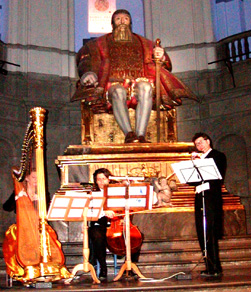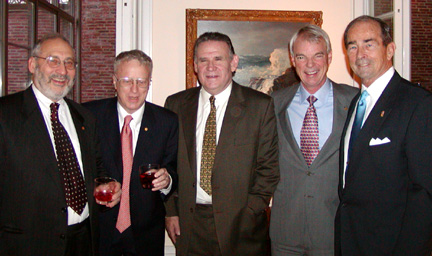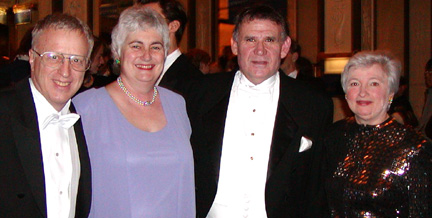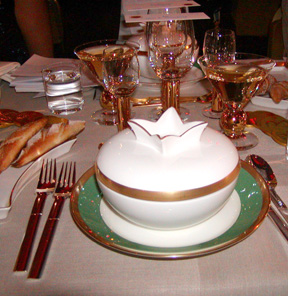|
Web Exclusives: PAWPLUS Posted March 27, 2002: What follows is a story written by Lynn Greenberg and her husband, Michael Rothschild, who attended last year's Nobel Prize ceremony in Sweden. Rothschild is a professor of economics and public affairs, and former dean of the Woodrow Wilson School. The 2001 Nobel Prize in Economics was given to Joseph Stiglitz, Michael Spence ’66, and George Akerlof for their work in asymmetric information. The prize announcement noted that Stiglitz's most important contribution to asymmetric information was a a paper he had written with Michael Rothschild. Greenberg is a senior clinical social worker at McCosh Health Center at Princeton. Photos are courtesy Lynn Greenberg. Dancing in a magical land The Nobel Prize Centennial Celebration — 2001 By Lynn Greenberg and Michael Rothschild October 11, 2001, the Swedish Royal Academy of Sciences announced that the Nobel Prize in Economics would be awarded to George Akerlof, Michael Spence '66, and Joseph Stiglitz for their work on asymmetric information. The Academy noted that Stiglitz's most important contribution to asymmetric information was a paper that he had written with Michael. To celebrate the 2001 Centennial celebration of the Nobel Prize, the Royal Academy invited all living laureates to return to Stockholm. They also invited us to come for the first time; we accepted with great pleasure. Michael flew on Sunday to attend a behavioral economics conference that preceded the Nobel celebrations. The conference was spectacularly good; the presenters and their discussants wanted to impress the Nobel committee; papers and discussions discussants were excellent. The presence of many laureates made this one of the most intelligent and thought provoking conferences Michael ever attended. Lynn joined Michael on Friday morning at the Grand Hotel, which is indeed grand — luxurious, friendly, and filled with past and present Nobel laureates and their families. Friday afternoon we wondered the old town of Stockholm — wonderful, narrow, cobble-stone streets lined with shops on the ground floor of seemingly quite tall buildings. Though buildings were only a few stories high, the narrowness of the streets and the ever-cloudy skies turned our stroll into a walk in a deep canyon. We glimpsed each side street through an archway. Beyond the arch lines of stores and buildings drew our eyes to a view of green (park), blue gray (ocean) and white-gray (clouds and sky) in the distance. We dined early at the famous Opera House. The Christmas table has been called the best meal in the world. Michael decided this was a proposition worth testing (tasting) in great detail. He reports that it certainly is the best herring, salmon, and smoked reindeer dinner in the world. Swedes can do more things with herring and salmon than Italians can do with pasta. Special buses took invited guests and previous laureates to and from the many events that were part of the Centennial celebration. This year's laureates each had a limousine marked Nobel Laureate. Saturday we went to speeches by this year's economics prizewinners. Returning to the hotel, we were besieged by autograph collectors. One asked Michael for his autograph; Michael responded: "You don't want my autograph." We were walking with Paul Samuelson (Nobel class of 1970 henceforth N1970) and at 86 still one of the quickest minds in the West. Paul said to Michael: "Yes he does," and signed: "Michael Rothschild of Princeton." After that, Michael signed autographs when asked. The next day we wandered through newer parts of clean, modern Stockholm. Stockholm escaped bombing in WWII and retains a slightly Victorian/fairy tale look. The people are warm, helpful, and proper — especially the salesman who (correctly) pointed out to us which red tie was "in" and which (the one we had picked) was not. Sunday was an elegant lunch at the U.S. embassy. Ambassador Heimbold, had just retired as head of Bristol Meyer Squibb (located near Princeton). He welcomed Michael before introducing the Nobel laureates. Before lunch Michael had a chance to talk briefly with Joe Stiglitz, Mike Spence, and George Akerlof. Lynn took pictures. At lunch Michael sat next to a charming blonde blue-eyed woman. She is the companion of Jšrgen Weibull, the member of the Nobel Prize committee who would give the formal speech about this year's economic prize the next day. Michael, smitten, assumed his lunch partner was Scandinavian. In the course of lunch he found out that she was Israeli and, until recently, had spent most of her time in Mexico. That evening buses took us to a reception at the Nordic Museum. The reception spilled into a display of fabulous gowns — many of which had actually been worn. While a string trio played under a gigantic statue of Stockholm's founder, champagne flowed, as did salmon, fruit, sweets, and talk. While chatting with 80-year-old Ken Arrow (N1972) Michael found that Ken was working, from a different angle, on the problem Michael planned to start work on in June. Michael concluded that he should start sooner. Dinner was set up with tables in many rooms. The PA system howled and screeched and had to be abandoned. We were then treated to what one of our companions described as the worst of all worlds: With speeches going on, it was impolite to talk, but we couldn't hear anything being said. After dinner we strained to hear speeches from Akerlof and Stiglitz. A question period followed. People left their tables and stood where they could see and hear each other. Remarkably, Milton Friedman, Gary Becker, Bob Solow, Paul Samuelson, Jim Mirrlees, Bob Merton, Doug North, and Amartya Sen — all Nobel Prize—winners and all with strong — and disparate — views of the world sat in one room and politely discussed current economic policy. Monday we ventured into the big department store, NK, to shop for holiday gifts. Back at the hotel, Lynn napped and Michael exercised before the ceremony. (Michael took his nap during part of the ceremony.) For the awarding of the prizes, the royal family sat on stage with more than 150 living Laureates — definitely a once-in-a-century spectacle. The speeches were in Swedish. Everyone was given a book containing the English translation. When the speech was made for the economic Prize, Michael's name and contribution was recognized. (He was awake for this part and is pondering how to put the text on T-shirts.) Most extraordinary was the theatricality of the event. A flourish of trumpets announced each new course. More than 150 choreographed wait staff marched down the stairs and assumed positions around the hall. They served all 1,400 guests in less than three minutes. Then they flowed out of the hall in unison. The Royal Opera provided more "divertissement," playing pieces from Don Carlos, Falstaff, and other Verdi operas. Ann Sofie von Otter reappeared — this time not overpowered. Before dessert we heard and saw the first scene from The Masked Ball, a Verdi opera set in Stockholm. For the dessert course, the servers descended the grand staircase carrying trays that were lit from within the desserts. After dinner we all ascended the grand staircase to the Golden Hall that actually is decorated with gold. Television cameras captured elegant revelers dancing. Two cash bars in the alcoves clashed with the elegant ambience. After the dance we attended the Nobel Nightcap, a party hosted by Swedish medical students. It was informal and private: no television, no reporters, no cameras. It was the perfect place to unwind after the festivities. Medical students had spent a week transforming a drab administrative building of the Karolinska Institute into living scenes with characters from Harry Potter, Lord of the Rings, Greek and Nordic myths, and other fairy tales. Michael awoke Sleeping Beauty with a kiss. The fun went on until 5 a.m. Enchanted and blurry eyed we flew back to Newark and reality.
|

 That
evening was the Nobel concert with opera and songs from American
musicals. Soloists were the baritone, Bryn Terfel (a wonderful ham),
and the soprano, Anne Sofie von Otter (whom the orchestra overpowered).
The beginning was dramatic. The audience was chatting and the musicians
were tuning their instruments. Anticipation hung in the air. Suddenly
the orchestra was still. The audience rose in silence. The royal
family entered their box. Everyone sang the Swedish national anthem;
the royal family sat. The king nodded; the concert began. After
the intermission, this scene was repeated in the same eerie silence
— without the anthem.
That
evening was the Nobel concert with opera and songs from American
musicals. Soloists were the baritone, Bryn Terfel (a wonderful ham),
and the soprano, Anne Sofie von Otter (whom the orchestra overpowered).
The beginning was dramatic. The audience was chatting and the musicians
were tuning their instruments. Anticipation hung in the air. Suddenly
the orchestra was still. The audience rose in silence. The royal
family entered their box. Everyone sang the Swedish national anthem;
the royal family sat. The king nodded; the concert began. After
the intermission, this scene was repeated in the same eerie silence
— without the anthem.
 A
dinner for economists, hosted by the Economics Club of Stockholm,
followed the reception. It began with drinks in a large boardroom.
Space for mingling was not generous; a huge conference table filled
the room. It was hot and crowded; most people gathered near the
bar. We went to the other end of the room, opened a window, and
talked with Emma Rothschild, who had just written an original interpretation
of the work of Adam Smith. Emma, who studied economics at MIT shortly
after Michael, is married to Amartya Sen (N1998). She is a "real"
Rothschild. She told Michael that the name "Rothschild"
had no cachet; a red shield was the sign of a pawnbroker and the
origins of the name Rothschild.
A
dinner for economists, hosted by the Economics Club of Stockholm,
followed the reception. It began with drinks in a large boardroom.
Space for mingling was not generous; a huge conference table filled
the room. It was hot and crowded; most people gathered near the
bar. We went to the other end of the room, opened a window, and
talked with Emma Rothschild, who had just written an original interpretation
of the work of Adam Smith. Emma, who studied economics at MIT shortly
after Michael, is married to Amartya Sen (N1998). She is a "real"
Rothschild. She told Michael that the name "Rothschild"
had no cachet; a red shield was the sign of a pawnbroker and the
origins of the name Rothschild.
 The
evening required the most formal attire. While some European men
sported ribbons and medals, most men looked alike in white tie and
tails. Women were jeweled, elegant, and glowing in long gowns. We
thought of penguins and peacocks.
The
evening required the most formal attire. While some European men
sported ribbons and medals, most men looked alike in white tie and
tails. Women were jeweled, elegant, and glowing in long gowns. We
thought of penguins and peacocks.
 An
elegant dinner for ,1400 people followed. This is the Swedish social
event of the year. It, and the ceremonies, are on national television.
When we entered the hall, we were given a book that listed everyone's
name and seating assignment, the floor plan, and the names of everyone
at each table. The place settings were distingué. The glassware
(by Orrefors and used only at this dinner) had gold stems. The dishes
were trimmed in gold, and the flatware was gold. The three-course
meal was elegant and delicious; the wines were memorable. The Stockholm
newspapers printed the recipes the following day.
An
elegant dinner for ,1400 people followed. This is the Swedish social
event of the year. It, and the ceremonies, are on national television.
When we entered the hall, we were given a book that listed everyone's
name and seating assignment, the floor plan, and the names of everyone
at each table. The place settings were distingué. The glassware
(by Orrefors and used only at this dinner) had gold stems. The dishes
were trimmed in gold, and the flatware was gold. The three-course
meal was elegant and delicious; the wines were memorable. The Stockholm
newspapers printed the recipes the following day.